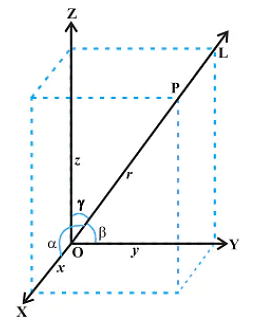The plane passing through the line L :lx – y + 3(1 – l) z = 1, x + 2y – z = 2 and perpendicular to the plane 3x + 2y + z = 6 is 3x – 8y + 7z = 4. If θ is the acute angle between the line L and the y-axis, then 415 cos2θ is equal to ________.
The plane passing through the line L :lx – y + 3(1 – l) z = 1, x + 2y – z = 2 and perpendicular to the plane 3x + 2y + z = 6 is 3x – 8y + 7z = 4. If θ is the acute angle between the line L and the y-axis, then 415 cos2θ is equal to ________.
Correct Answer: 125
Solution and Explanation
L :lx – y + 3 (1 – l)z = 1, x + 2y – z = 2
and plane containing the line p : 3x – 8y + 7z = 4
Let \(\vec{n}\) be the vector parallel to L.
then
\(\vec{n}=\begin{vmatrix} \hat{i} & \hat{j} & \hat{k} \\ l & -1 & 3(1-l) \\ 1 & 2 & -1 \\ \end{vmatrix}\)
\(=(6l−5)\hat{i}+(3−2l)\hat{j}+(2l+1)\hat{k}\)
∵ R containing L
3(6l – 5) – 8(3 – 2l) + 7 (2l + 1) = 0
18l + 16l + 14l – 15 – 24 + 7 = 0
\(∴l=\frac{32}{48}=\frac{2}{3}\)
Let θ be the acute angle between L and y-axis
\(∴ \cos \theta=\frac{\frac{5}{3}}{\sqrt{1+\frac{25}{9}+\frac{49}{9}}}=\frac{5}{\sqrt{83}}\)
\(∴ 415\cos^2 \theta=125\)
Top Questions on Three Dimensional Geometry
- If A(2,1,-1), B(6,-3,2), C(-3,12,4) are the vertices of a triangle ABC and the equation of the plane containing the triangle ABC is $53x+by+cz+d=0$, then $\frac{d}{b+c}=$
- TS EAMCET - 2025
- Mathematics
- Three Dimensional Geometry
- If $(\alpha, \beta, \gamma)$ is the foot of the perpendicular drawn from a point $(-1,2,-1)$ to the line joining the points $(2,-1,1)$ and $(1,1,-2)$, then $\alpha+\beta+\gamma=$
- TS EAMCET - 2025
- Mathematics
- Three Dimensional Geometry
- If m:n is the ratio in which the point $\left(\frac{8}{5}, \frac{1}{5}, \frac{8}{5}\right)$ divides the line segment joining the points (2,p,2) and (p,-2,p) where p is an integer then $\frac{3m+n}{3n}=$
- TS EAMCET - 2025
- Mathematics
- Three Dimensional Geometry
- Let $\pi_1$ be the plane determined by the vectors $\hat{i}+\hat{j}, \hat{i}+\hat{k}$ and $\pi_2$ be the plane determined by the vectors $\hat{j}-\hat{k}, \hat{k}-\hat{i}$. Let $\vec{a}$ be a non-zero vector parallel to the line of intersection of the planes $\pi_1$ and $\pi_2$. If $\vec{b} = \hat{i}+\hat{j}-\hat{k}$ then the angle between the vectors $\vec{a}$ and $\vec{b}$ is
- TS EAMCET - 2025
- Mathematics
- Three Dimensional Geometry
Show that the following lines intersect. Also, find their point of intersection:
Line 1: \[ \frac{x - 1}{2} = \frac{y - 2}{3} = \frac{z - 3}{4} \]
Line 2: \[ \frac{x - 4}{5} = \frac{y - 1}{2} = z \]
- CBSE CLASS XII - 2025
- CBSE Compartment XII - 2025
- Mathematics
- Three Dimensional Geometry
Questions Asked in JEE Main exam
- Let \( A = [a_{ij}] \) be a matrix of order 3 \(\times\) 3, with \(a_{ij} = (\sqrt{2})^{i+j}\). If the sum of all the elements in the third row of \( A^2 \) is \( \alpha + \beta\sqrt{2} \), where \(\alpha, \beta \in \mathbb{Z}\), then \(\alpha + \beta\) is equal to:
- JEE Main - 2025
- Matrices and Determinants
Consider the following sequence of reactions :

Molar mass of the product formed (A) is ______ g mol\(^{-1}\).- JEE Main - 2025
- Organic Chemistry
The magnitude of heat exchanged by a system for the given cyclic process ABC (as shown in the figure) is (in SI units):

- JEE Main - 2025
- Electric charges and fields
- The value of \( (\sin 70^\circ)(\cot 10^\circ \cot 70^\circ - 1) \) is:
- JEE Main - 2025
- Trigonometric Identities
- The number of 6-letter words, with or without meaning, that can be formed using the letters of the word "MATHS" such that any letter that appears in the word must appear at least twice is:
- JEE Main - 2025
- Calculus
Concepts Used:
Three Dimensional Geometry
Mathematically, Geometry is one of the most important topics. The concepts of Geometry are derived w.r.t. the planes. So, Geometry is divided into three major categories based on its dimensions which are one-dimensional geometry, two-dimensional geometry, and three-dimensional geometry.
Direction Cosines and Direction Ratios of Line:
Consider a line L that is passing through the three-dimensional plane. Now, x,y and z are the axes of the plane and α,β, and γ are the three angles the line makes with these axes. These are commonly known as the direction angles of the plane. So, appropriately, we can say that cosα, cosβ, and cosγ are the direction cosines of the given line L.
